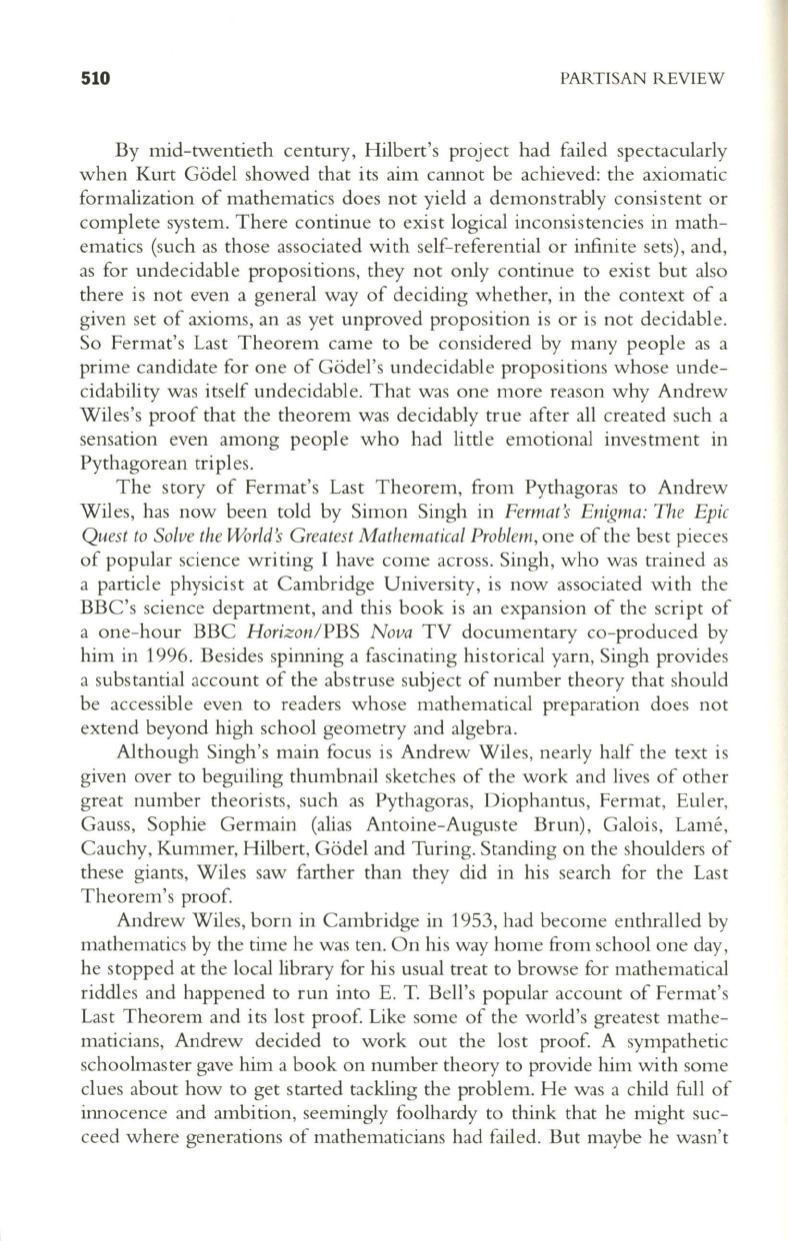
510
PARTISAN REVIEW
By mid-twentieth century, Hilbert's project had failed spectacularly
when Kurt Godel showed that its aim cannot be achieved: the axiomatic
formalization of mathematics does not yield a demonstrably consistent or
complete system. There continue to exist logical inconsistencies in math–
ematics (such as those associated with self-referential or infinite sets), and,
as for undecidable propositions, they not only continue to exist but also
there is not even a general way of deciding whether, in the context of a
given set of axioms, an as yet unproved proposition is or is not decidable.
So Fermat's Last Theorem came to be considered by many people as a
prime candidate for one of Godel's undecidable propositions whose unde–
cidability was itself undecidable. That was one more reason why Andrew
Wiles's proof that the theorem was decidably true after all created such a
sensation even among people who had little emotional investment in
Pythagorean triples.
The story of Fermat's Last Theorem, from Pythagoras to Andrew
Wiles, has now been told by Simon Singh in
Fermat's Enigma: The Epic
Quest to Solve the World's Greatest Mathematical Problem,
one of the best pieces
of popular science writing I have come across. Singh, who was trained as
a particle physicist at Cambridge University, is now associated with the
BBC's science department, and this book is an expansion of the script of
a one-hour BBC
Horizon/PBS Nova
TV documentary co-produced by
him in 1996. Besides spinning a fascinating historical yarn, Singh provides
a substantial account of the abstruse subject of number theory that should
be accessible even to readers whose mathematical preparation does not
extend beyond high school geometry and algebra.
Although Singh's main focus is Andrew Wiles, nearly half the text is
given over to beguiling thumbnail sketches of the work and lives of other
great number theorists, such as Pythagoras, Diophantus, Fermat, Euler,
Gauss, Sophie Germain (alias Antoine-Auguste Brun), Galois, Lame,
Cauchy, Kummer, Hilbert, Godel and Turing. Standing on the shoulders of
these giants, Wiles saw farther than they did in his search for the Last
Theorem's proof.
Andrew Wiles, born
in
Cambridge in 1953, had become enthralled by
mathematics by the time he was ten. On his way home from school one day ,
he stopped at the local library for his usual treat
to
browse for mathematical
riddles and happened to run into E. T. Bell's popular account of Fermat's
Last Theorem and its lost proof. Like some of the world's greatest mathe–
maticians, Andrew decided to work out the lost proof. A sympathetic
schoolmaster gave him a book on number theory to provide him with some
clues about how to get started tackling the problem. He was a child full of
innocence and ambition, seemingly foolhardy to think that he might suc–
ceed where generations of mathematicians had failed. But maybe he wasn't


